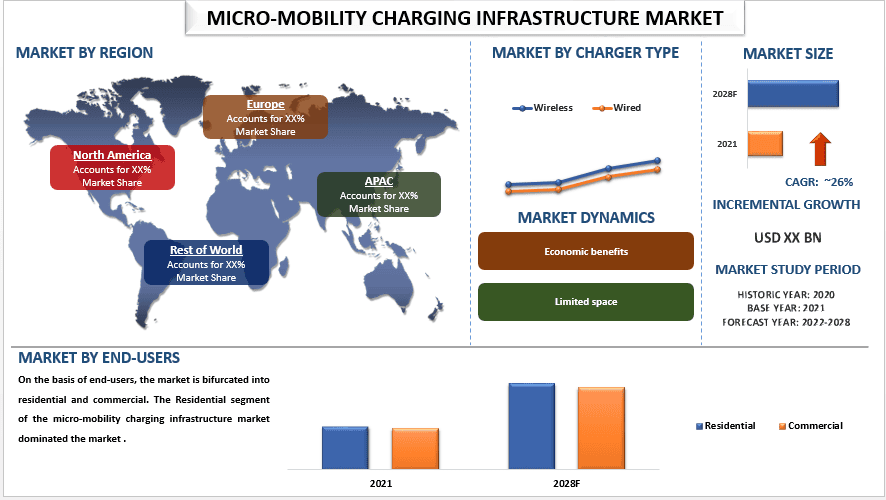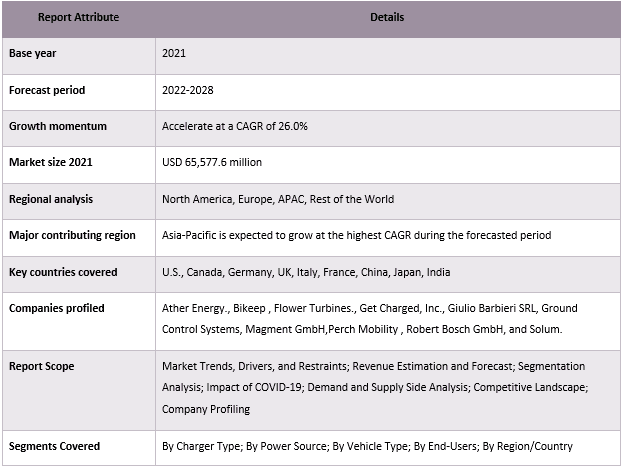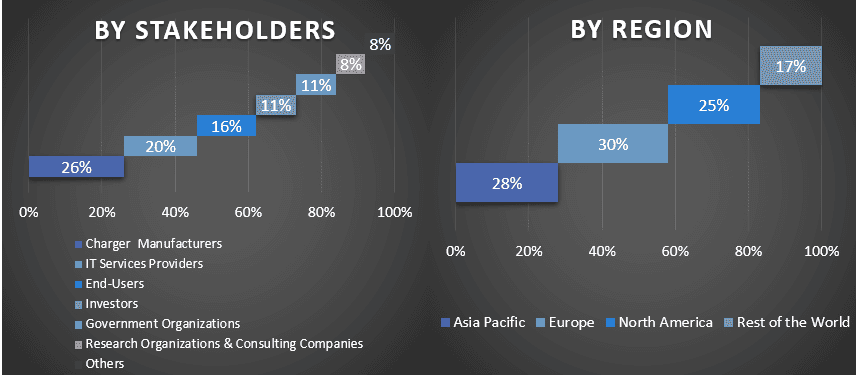- Home
- About Us
- Industry
- Services
- Reading
- Contact Us
Micro-Mobility Charging Infrastructure Market: Current Analysis and Forecast (2022-2028)
Emphasis on Charger Type (Wired and Wireless], Power Source (Solar Powered and Battery Powered); Vehicle Type (E-scooters, E-bikes, E-unicycles, and E-skateboards) and End-Users (Residential and Commercial); and Region/Country

Micro-Mobility Charging Infrastructure Market was valued at USD 140 million in 2021 & is expected to grow at a CAGR of 26.0% from 2022-2028.
Another driver is the growing investment in the development of charging infrastructure by companies in the micro-mobility space. Regulatory support has also played a role in driving growth in the micro-mobility charging infrastructure market. Many cities and governments around the world have implemented policies and initiatives to encourage the use of micro-mobility options, which has led to an increase in demand for charging infrastructure. For example, in March 2021, the UK government announced a £20 million investment in electric vehicle charging infrastructure, including the development of more than 4,000 charging points for electric bikes and scooters.
Advancements in technology have also contributed to the growth of the micro-mobility charging infrastructure market. For example, Swappable, a startup based in the Netherlands, has developed a universal battery swapping system that can be used by any micro-mobility vehicle. The system allows users to easily exchange depleted batteries for fully charged ones, eliminating the need for charging stations.
Some of the major players operating in the market include Schneider Electric; Siemens; ABB; Samsung; Honeywell International; Robert Bosch GmbH; LG Electronics; ASSA ABLOY; ACUITY BRANDS, INC.; and Cisco Systems, Inc. Several M&As along with partnerships have been undertaken by these players to facilitate customers with hi-tech and innovative products/technologies.
Insights Presented in the Report
“Amongst product, the smart appliances segment held a dominating share of the market in 2021”
Based on product, the market is segmented into security and safety, smart appliances, home entertainment, lighting and control, heating ventilating, air conditioning (HVAC), and energy management. Amongst these, the smart appliances segment dominated the market in 2021. This is because smart appliances allow users to connect, control and monitor their own devices, saving time, energy, and money. For example, you can plan run times to suit your personal schedule, use cheaper off-peak energy, or take full advantage of solar energy to save time, money, and the environment.
“Amongst technology, the wireless micro-mobility charging infrastructure technology held the majority share of the market in 2021.”
By technology, the market is bifurcated into wireless micro-mobility charging infrastructure technology and wired smart technology. Among these, wireless micro-mobility charging infrastructure technology captured the majority share of the micro-mobility charging infrastructure market in 2021. The major share of the wireless micro-mobility charging infrastructure technology can be attributed to the capabilities and features offered such as mobile connectivity, connectivity regardless of location, and more by protocols such as ZigBee, Wi-Fi, Bluetooth, Z Wave, and others.
“North America experienced significant growth.”
North America has experienced significant growth in the micro-mobility charging infrastructure market due to several drivers. One key driver is the increasing popularity of micro-mobility options, such as electric scooters and bikes, as people look for convenient and sustainable modes of transportation. This has led to an increase in demand for charging infrastructure to support these vehicles. Another driver is the increasing investment in the development of charging infrastructure by companies in the micro-mobility space. For example, in November 2021, Lime announced a $50 million investment in charging infrastructure, including the deployment of 100,000 charging stations across North America. This investment is expected to significantly improve the availability and accessibility of charging infrastructure for micro-mobility vehicles.
In addition, regulatory support has played a role in driving growth in the micro-mobility charging infrastructure market. Many cities in North America have implemented policies and initiatives to encourage the use of micro-mobility options, which has led to an increase in demand for charging infrastructure. For example, the City of Toronto recently launched an e-scooter pilot program that includes the installation of more than 1,200 charging stations across the city.
Micro-mobility charging infrastructure Market Report Coverage

Reasons to buy this report:
- The study includes market sizing and forecasting analysis validated by authenticated key industry experts.
- The report presents a quick review of overall industry performance at one glance.
- The report covers an in-depth analysis of prominent industry peers with a primary focus on key business financials, product portfolios, expansion strategies, and recent developments.
- Detailed examination of drivers, restraints, key trends, and opportunities prevailing in the industry.
- The study comprehensively covers the market across different segments.
- Deep dive regional level analysis of the industry.
Customization Options:
The global micro-mobility charging infrastructure market can further be customized as per the requirement or any other market segment. Besides this, UMI understands that you may have your own business needs, hence feel free to connect with us to get a report that completely suits your requirements.
Table of Content
Research Methodology for the Micro-mobility charging infrastructure Market Analysis (2022-2028)
Analyzing the historical market, estimating the current market, and forecasting the future market of the global micro-mobility charging infrastructure market were the three major steps undertaken to create and analyze the adoption of micro-mobility charging infrastructure in major regions globally. Exhaustive secondary research was conducted to collect the historical market numbers and estimate the current market size. Secondly, to validate these insights, numerous findings and assumptions were taken into consideration. Moreover, exhaustive primary interviews were also conducted, with industry experts across the value chain of the global micro-mobility charging infrastructure market. Post assumption and validation of market numbers through primary interviews, we employed a top-down/bottom-up approach to forecasting the complete market size. Thereafter, market breakdown and data triangulation methods were adopted to estimate and analyze the market size of segments and sub-segments of the industry pertains to. Detailed methodology is explained below:
Analysis of Historical Market Size
Step 1: In-Depth Study of Secondary Sources:
Detail secondary study was conducted to obtain the historical market size of the micro-mobility charging infrastructure market through company internal sources such as annual reports & financial statements, performance presentations, press releases, etc., and external sources including journals, news & articles, government publications, competitor publications, sector reports, third-party database, and other credible publications.
Step 2: Market Segmentation:
After obtaining the historical market size of the micro-mobility charging infrastructure market, we conducted a detailed secondary analysis to gather historical market insights and share for different segments & sub-segments for major regions. Major segments are included in the report as product, technology, and end-users. Further country-level analyses were conducted to evaluate the overall adoption of testing models in that region.
Step 3: Factor Analysis:
After acquiring the historical market size of different segments and sub-segments, we conducted a detailed factor analysis to estimate the current market size of the micro-mobility charging infrastructure market. Further, we conducted factor analysis using dependent and independent variables such as product, technology, and end-users of the micro-mobility charging infrastructure market. A thorough analysis was conducted for demand and supply-side scenarios considering top partnerships, mergers and acquisitions, business expansion, and product launches in the micro-mobility charging infrastructure market sector across the globe.
Current Market Size Estimate & Forecast
Current Market Sizing: Based on actionable insights from the above 3 steps, we arrived at the current market size, key players in the global micro-mobility charging infrastructure market, and market shares of the segments. All the required percentage shares split, and market breakdowns were determined using the above-mentioned secondary approach and were verified through primary interviews.
Estimation & Forecasting: For market estimation and forecast, weights were assigned to different factors including drivers & trends, restraints, and opportunities available for the stakeholders. After analyzing these factors, relevant forecasting techniques i.e., the top-down/bottom-up approach were applied to arrive at the market forecast for 2028 for different segments and sub-segments across the major markets globally. The research methodology adopted to estimate the market size encompasses:
- The industry’s market size, in terms of revenue (USD) and the adoption rate of the micro-mobility charging infrastructure market across the major markets domestically.
- All percentage shares, splits, and breakdowns of market segments and sub-segments
- Key players in the global micro-mobility charging infrastructure market in terms of products offered. Also, the growth strategies adopted by these players to compete in the fast-growing market
Market Size and Share Validation
Primary Research: In-depth interviews were conducted with the Key Opinion Leaders (KOLs) including Top Level Executives (CXO/VPs, Sales Head, Marketing Head, Operational Head, Regional Head, Country Head, etc.) across major regions. Primary research findings were then summarized, and statistical analysis was performed to prove the stated hypothesis. Inputs from primary research were consolidated with secondary findings, hence turning information into actionable insights.
Split of Primary Participants in Different Regions

Market Engineering
The data triangulation technique was employed to complete the overall market estimation and to arrive at precise statistical numbers for each segment and sub-segment of the global micro-mobility charging infrastructure market. data was split into several segments & sub-segments post studying various parameters and trends in the areas of the product, technology, and end-users in the global micro-mobility charging infrastructure market.
The main objective of the Global Micro-mobility charging infrastructure Market Study
The current & future market trends of the global micro-mobility charging infrastructure market were pinpointed in the study. Investors can gain strategic insights to base their discretion for investments on the qualitative and quantitative analysis performed in the study. Current and future market trends determined the overall attractiveness of the market at a regional level, providing a platform for the industrial participant to exploit the untapped market to benefit from a first-mover advantage. Other quantitative goals of the studies include:
- Analyze the current and forecast market size of the micro-mobility charging infrastructure market in terms of value (USD). Also, analyze the current and forecast market size of different segments and sub-segments
- Segments in the study include areas of the product, technology, and end-users
- Define and analysis of the regulatory framework for the micro-mobility charging infrastructure industry
- Analyze the value chain involved with the presence of various intermediaries, along with analyzing customer and competitor behaviors of the industry
- Analyze the current and forecast market size of the micro-mobility charging infrastructure market for the major region
- Major countries of regions studied in the report include Asia Pacific, Europe, North America, and the Rest of the World
- Company profiles of the micro-mobility charging infrastructure market and the growth strategies adopted by the market players to sustain in the fast-growing market
- Deep dive regional level analysis of the industry
Related Reports
Customers who bought this item also bought










